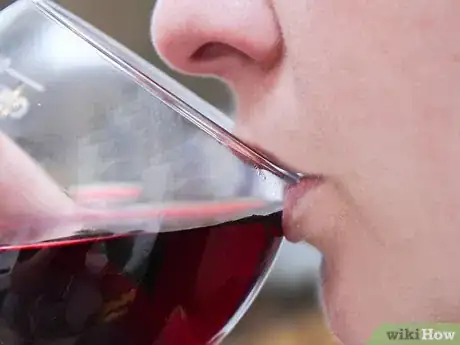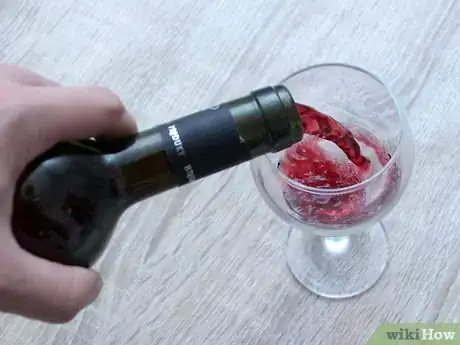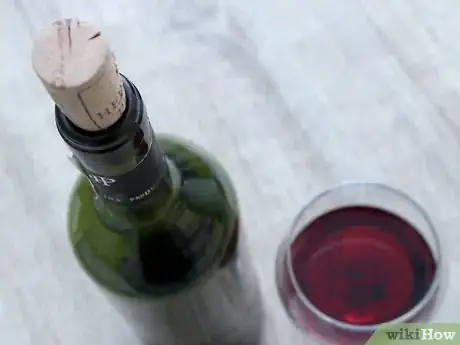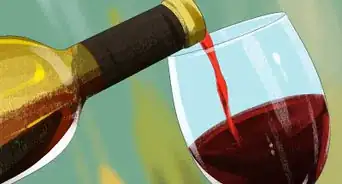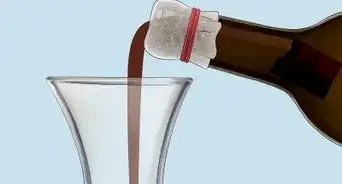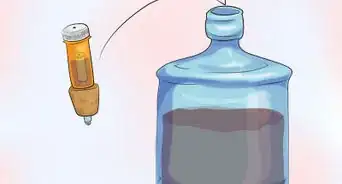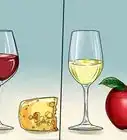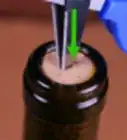This article was co-authored by Murphy Perng. Murphy Perng is a Wine Consultant and the Founder and Host of Matter of Wine, a business that produces educational wine events, including team-building experiences, networking events, and private parties. Based in Los Angeles, California, Murphy has served as a Wine Educator for clients such as Google, Buzzfeed, Tiktok, Snapchat, and Equinox and been featured on National Geographic and The Somm Journal. Murphy possesses her WSET (Wine & Spirit Education Trust) Level 3 Advanced Certification.
There are 8 references cited in this article, which can be found at the bottom of the page.
This article has been viewed 126,294 times.
Enjoying a good bottle of wine is one of life’s little pleasures. However, it is believed that about 5% of the world’s wines are corked, which leads to a less than pleasant wine-drinking experience.[1] If you have opened a bottle of wine, smell it before drinking to determine whether or not it is corked. If it smells OK, taste it to make sure that it has the strong, fresh flavors you expected when you bought it. If you discover that it is corked, take it back to the place where you purchased it for a replacement or a refund.
Steps
Determining Whether or Not Your Wine is Corked
-
1Smell the wine.[2] If wine is corked, it will have an odor that you wouldn’t expect from a good wine. It may smell musty, or like dank towels, wet dog, wet cardboard or newspaper.[3]
- Note that your first sniff is more reliable than later sniffs. Trust your first whiff!
- Wine becomes corked when it is exposed to TCA or "2,4,6-Trichloroanisole", a naturally occurring compound that may be found in the cork of the wine bottle.[4]
-
2Taste the wine. If the wine has only been exposed to a small amount of TCA, it may be difficult to decide for sure whether or not it is corked by smelling it alone. The taste of the wine will be dull and will not exhibit any fruit characteristics.[5] Some people also describe corked wine as tasting astringent.[6]
- A wine that is only slightly corked may lack aroma and have very little taste.
- If you did taste it, and it is corked, the taste was probably quite unenjoyable. It may have even tasted reminiscent of paint thinner. Rinse your mouth out with water, and open up a new bottle.
Advertisement -
3Always test the wine before allowing it to be served to others. This allows the host to see if the wine is fit for consumption and prevents pouring the wine into many glasses before a discovery that the wine is not fit for drinking. Return your corked wine to the store you purchased it from for a replacement or a refund.
- If you are in a restaurant and you purchase a bottle of wine, make sure the waiter allows you to taste the wine before serving any other guests at the table.
-
4Avoid confusing corked wine with other problems. If the wine seems a bit off to you, don’t just assume that it must be corked. There may be other culprits that have ruined the taste of your wine.[7]
- Oxidized wine is wine that has been exposed to oxygen, which has caused the wine to taste flat and lifeless, and even a bit vinegary. If your wine tastes this way (think of the way a flat soda tastes in comparison to a fresh one, as the concept is similar), then there is a good chance that it has simply oxidized. The color of the wine (if it is white) will also have changed to a dull yellow or brownish color.
- Maderized wine is wine that has been overheated, perhaps as a result of storage or during transport. This wine will taste reminiscent of almonds or candied fruits, and the cork may be pushed a bit out of the bottle. This occurs because of the expansion that occurs when the wine becomes too warm.
- It is also possible that the wine has refermented. Although wine is a product of fermentation, sometimes excess yeast can interact with the wine once it is bottled, creating a fizzy taste.
Understanding What Happens When Wine Becomes Corked
-
1Understand how wine becomes corked. A corked wine is a wine that has come into contact with a cork that has “cork taint.” This occurs when a wine cork comes into contact with a chemical commonly known as TCA (2,4,6-Trichloroanisole).[8]
- TCA forms when natural fungi present in corks comes into contact with certain chemicals found in sanitation and sterilization products used in wineries.
-
2Learn what corked does not mean. Many people mistakenly believe that corked wine is just wine that has little bits of cork floating in the wine. This is not the case. Although it may be annoying, the wine is not ruined.[9]
-
3Remember that it may not be the cork on the bottle that caused the contamination. Sometimes, you may come across a bottle of wine with a screw top, but it still tastes as though it is corked. In this case, the wine may have become contaminated in the barrel before it was bottled.
- If this is the case, you should definitely take the wine back to the seller. If a winery has sold an entire batch of corked wine, then you should reconsider the quality of that wine.
Expert Q&A
-
QuestionHow do you get pieces of cork out of your glass of wine?
 Murphy PerngMurphy Perng is a Wine Consultant and the Founder and Host of Matter of Wine, a business that produces educational wine events, including team-building experiences, networking events, and private parties. Based in Los Angeles, California, Murphy has served as a Wine Educator for clients such as Google, Buzzfeed, Tiktok, Snapchat, and Equinox and been featured on National Geographic and The Somm Journal. Murphy possesses her WSET (Wine & Spirit Education Trust) Level 3 Advanced Certification.
Murphy PerngMurphy Perng is a Wine Consultant and the Founder and Host of Matter of Wine, a business that produces educational wine events, including team-building experiences, networking events, and private parties. Based in Los Angeles, California, Murphy has served as a Wine Educator for clients such as Google, Buzzfeed, Tiktok, Snapchat, and Equinox and been featured on National Geographic and The Somm Journal. Murphy possesses her WSET (Wine & Spirit Education Trust) Level 3 Advanced Certification.
Certified Wine Consultant If you find bits of cork floating in your wine, simply filter it out by pushing a coffee filter halfway into your wine glass, and then slowly pour the wine through the filter.
If you find bits of cork floating in your wine, simply filter it out by pushing a coffee filter halfway into your wine glass, and then slowly pour the wine through the filter. -
QuestionWhen does it mean when pulling out the cork makes a hissing noise, and the cork is wet and soft with wine?
 Community AnswerIt means it's a properly bottled wine.
Community AnswerIt means it's a properly bottled wine. -
QuestionIs corked wine safe for a toddler to drink?
 Community AnswerA toddler should not be drinking wine at all. So, no, corked wine is not safe for toddlers.
Community AnswerA toddler should not be drinking wine at all. So, no, corked wine is not safe for toddlers.
Warnings
- If you come across a bottle of wine in your collection that is corked, get rid of it. You don’t want it to contaminate any of your other wine.⧼thumbs_response⧽
References
- ↑ http://vinepair.com/wine-101/tell-wine-corked/
- ↑ Murphy Perng. Certified Wine Consultant. Expert Interview. 15 March 2019.
- ↑ http://winefolly.com/tutorial/how-to-tell-corked-wine/
- ↑ http://www.thekitchn.com/what-is-corked-wine-what-does-corked-wine-taste-like-164148
- ↑ Murphy Perng. Certified Wine Consultant. Expert Interview. 15 March 2019.
- ↑ http://vinepair.com/wine-101/tell-wine-corked/
- ↑ http://nymag.com/restaurants/articles/wine/essentials/badwine.htm
- ↑ http://www.thekitchn.com/what-is-corked-wine-what-does-corked-wine-taste-like-164148
- ↑ http://vinepair.com/wine-blog/how-do-i-filter-out-pieces-of-cork-from-my-wine/
About This Article
To tell if your wine is corked, start by smelling the wine to see if it smells musty, like a wet dog or cardboard. When you smell your wine, trust your first sniff, since it’s the most reliable. If you can’t tell by the smell alone, take a sip of the wine and check to see if it tastes dull or astringent without any fruit flavor. Your wine may also taste a bit off from overheating in storage or during transport, in which case it would taste like almonds or candied fruits. For more tips, like how to remove actual pieces of cork, read on!



